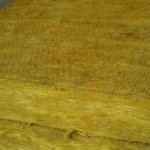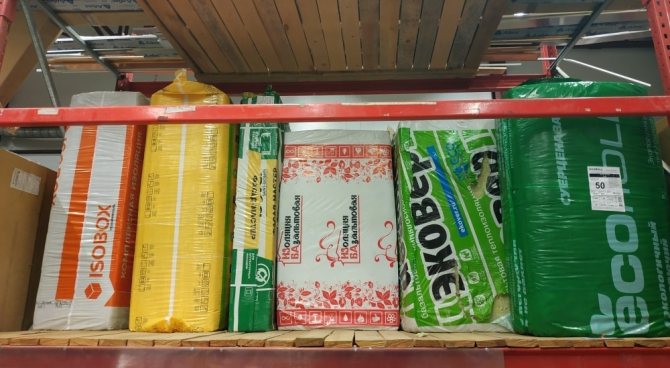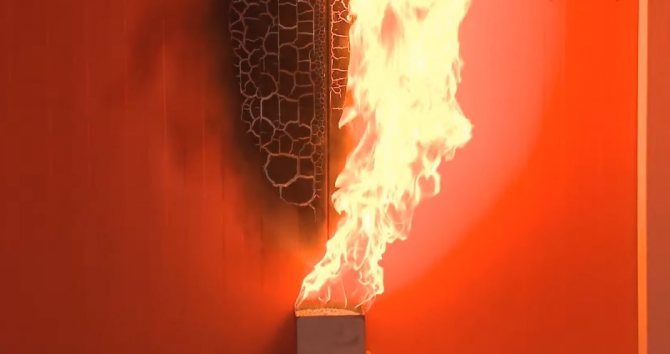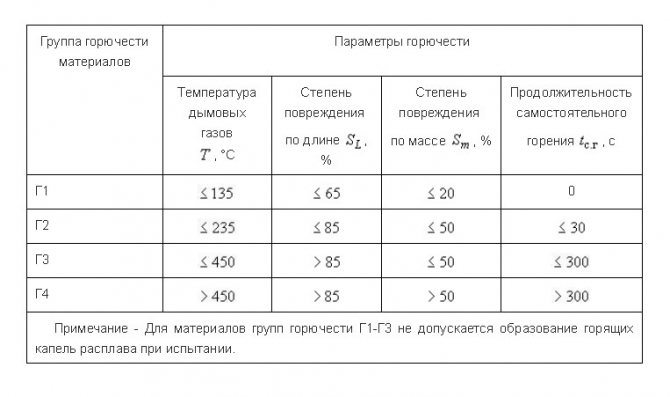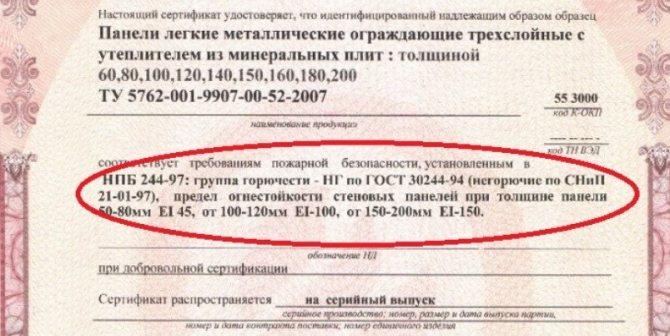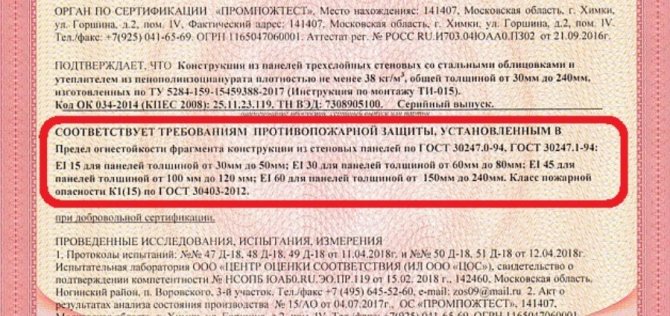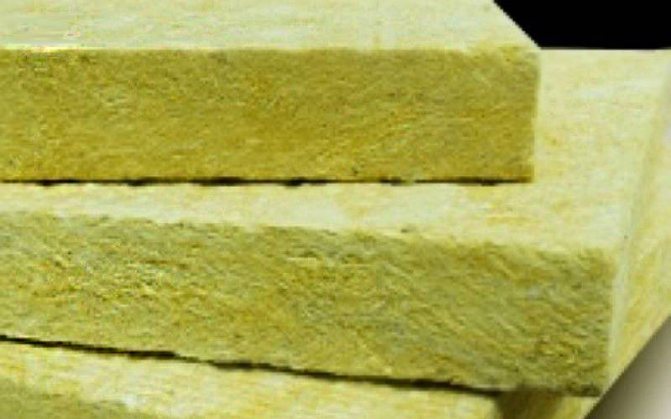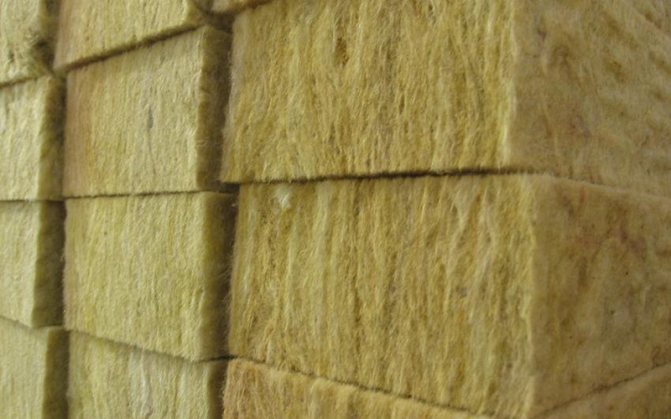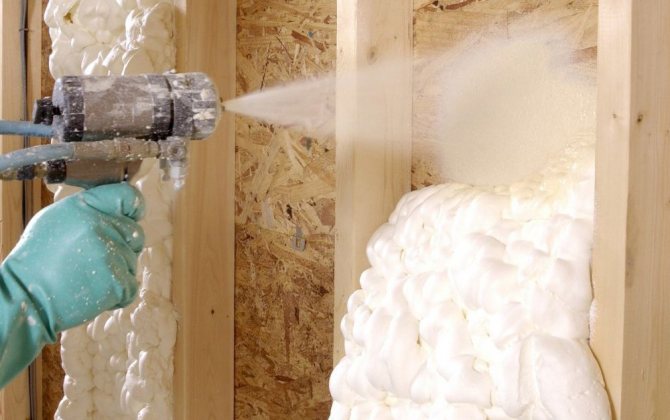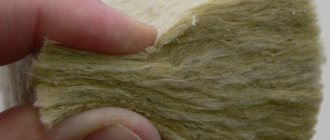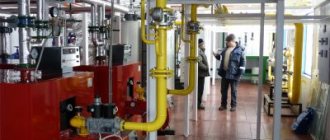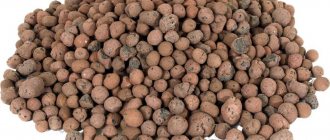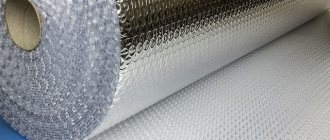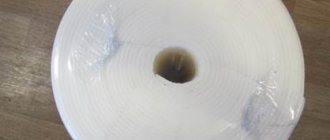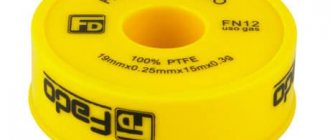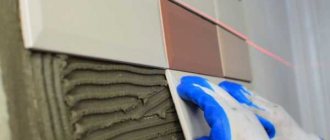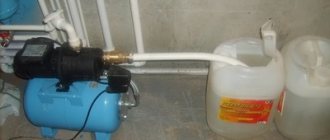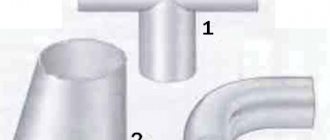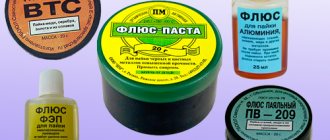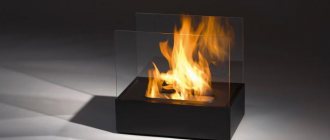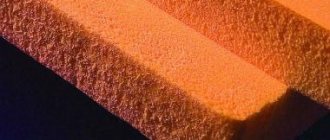Forms of mineral wool thermal insulation materials
Almost any type of mineral wool can be produced in various forms, which compensates for the initial shortcomings of the material and makes it convenient to use for certain purposes. The list of the most common ones is as follows:
- Plates. Compressed mineral wool can be in the form of rigid plates, which are convenient to use as part of the currently popular sandwich insulation systems.
- Two-layer slabs. In this case, the first layer has a supporting function, imparting additional rigidity to the material, while the second (inner) layer provides the main thermal insulation. Excellent for external insulation, especially in combination with decorative or heat-insulating plaster.
- Lamellar plates. A feature of this format is the perpendicular arrangement of the fibers relative to the surface plane. As a result, the heat-insulating properties are somewhat narrowed, but the material acquires greater plasticity, which makes it possible to actively use it when insulating surfaces of complex shapes.
- Laminated slabs. On one side such products are covered with a layer of polymer or fiberglass, which gives the material additional protection against destruction under the influence of air currents and condensation. Also often used in sandwich systems.
- Plates with a foil layer. A layer of foil, fixed with fiberglass mesh, acts as a vapor barrier required for external insulation.
- Wired mats. This flexible material is most often suitable for thermal insulation of attics and attic spaces. Before use, rolls of stitching mats must be left unfolded for some time to take their original shape.
- Mineral wool granules. Scraps from the production of one type of rockwool can also be a good insulation material. They find their application in specific blown insulation, which is implemented in the event that it is not possible to dismantle the decorative wall decoration.
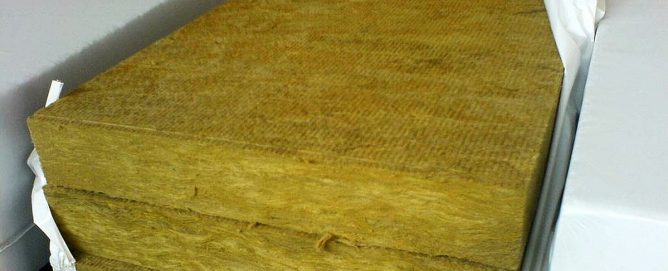
Fire protection temperature from the type of cotton wool
The range of temperatures that various types of such fire-resistant materials can withstand as much as possible during long-term operation:
- Kaolin (mullite-silica) wool brand MKRR-130 - 1150 ℃; MKRH-150 - 1300 ℃.
- Basalt mineral wool - up to 1200 degrees Celsius.
- Silica wool - up to 1100 ℃.
- Glass wool - 450 ℃.
- Slag wool - up to 300 ℃.
***Critical thermal shock at 1500 degrees Celsius will not be able to withstand even kaolin (mullite-silica) wool, although made from a melt of raw materials at a temperature of 1750 ℃, but containing binders with a lower melting limit. Fire-resistant wadding is not designed for use in such extra-heavy conditions.
For these purposes, use other refractory materials and products with protection from temperatures above 1580 ℃.
Additional modifications
When creating thermal insulation for inclined and vertical surfaces, a multilayer and rather complex system is performed, consisting of a windscreen, a moisture and vapor barrier.
Mineral wool with foil is great for preventing heat leakage as much as possible
To facilitate the installation of such a structure, special mats made of mineral fibers will help, which are equipped with additional layers, made according to the principle:
- laminating - fiberglass or polymer thin film prevents the blowing of fibers from the common layer by the wind;
- foiling - preventing moisture from entering the middle of the insulation, heat is retained in the room due to its reflection from the mirror surface;
- creating an external bituminous layer that acts as a waterproofing protection.
Mineral wool slabs are versatile and multifunctional, thanks to which they have found a huge scope of use. Knowing the elementary features and technical parameters, you can independently choose a heat insulator for arranging a living space.
Mineral wool board is a heat-insulating material made of mineral wool and a synthetic binder. The miniplate is resistant to high temperatures, and if it was made from natural rocks, they will begin to melt only after two hours of exposure to a temperature of a thousand degrees. In addition, the mineral wool board is resistant to most aggressive chemical substances: alkalis, oils, solvents. Mineral wool (mineral wool) slabs have different hardness and density. Another advantage is a high vapor permeability coefficient, which makes it possible to freely penetrate water vapor. This helps keep the material from moisture formation, which can lead to the spread of mold and various pests.
The advantages of a mineral wool board include the following: - Low moisture absorption - no more than 1.5%. - Complete incombustibility. - Ease and ease of use. The material does not need special fasteners, it is easy to cut and lay. - The fibrous structure provides elasticity and high strength to the material. - No deformation even under heavy loads. - Due to the fibrous structure, such a board is a good sound insulator. This quality is very useful in industrial construction, as the sound insulation properties help to reduce the thickness of the installed insulation. - Durability. The material performs its functions up to 25 years. - Environmental friendliness. - High thermal insulation properties.
Use of mineral wool boards
Mineral wool boards differ in the degree of hardness. This is how soft, semi-rigid and hard slabs are distinguished. In construction, semi-rigid and rigid ones are more often used: the former for thermal insulation of wall partitions, roofs and in multilayer systems, and the latter for thermal insulation of roofs, facades, floors. Soft slabs are mainly used for thermal insulation of communications.
- Residential construction. The miniplate is the most common insulation for the house, it is used to insulate all parts of the building, including the floor and basement. - Insulation of floors. - Warming of inter-rafter spaces. - Thermal insulation of the facade. - Insulation of the roof and attic. - Insulation of water supply and heating equipment, as well as plumbing equipment and pipelines. - Industrial engineering.
This material can be used both on newly built houses and on those already in use. Today, mineral wool slabs are the safest, most environmentally friendly and effective heat and sound insulator.
Stone wool properties - pros and cons
Basalt slab as insulation, sound insulation and fire protection has many positive properties:
- low thermal conductivity in the range of 0.035–0.042 W / (m · ° C), approximately in the same range as that of expanded polystyrene;
- almost zero hygroscopicity - no more than 0.095% per day, which does not allow moisture to penetrate into the insulation mass, maintaining its properties in any unfavorable conditions. The inaccessibility of material for moisture penetration excludes the possibility of reproduction of microorganisms that are unfavorable to health, such as mold and fungus, in the body of the insulation;
- high vapor permeability in contrast to closed cell foam materials like expanded polystyrene or polyurethane foam.Basalt thermal insulation as part of the building envelope ensures the evaporation of any amount of moisture formed on the adjacent surfaces of walls, ceilings or roofs, excluding the negative effects of moisture. This quality of the material makes it possible to use it for thermal insulation of structures with high levels of humidity in rooms, such as saunas, laundry rooms or baths;
- high fire resistance is one of the unique properties of basalt wool. A mineral slab made of stone wool, belonging to the NG category, that is, non-combustible materials that can only melt at high temperatures, is used not only as a non-combustible insulation for walls and ceilings, but also as a fire retardant material that covers metal and reinforced concrete structures in order to increase fire protection;
- in addition to thermal insulation, wall insulation with mineral wool significantly increases their sound-insulating properties due to the structure of stone wool, most of the volume of which is filled with air between randomly located stone fibers, damping sound vibrations;
- has a high resistance to aggressive substances - oils, alkalis and acids, household chemicals, as well as high biological resistance to the influence of microorganisms - fungus and mold, which allows us to speak about the high durability of the material. From the experience of using stone wool in construction, it has been established that the durability of this insulation is guaranteed to reach 50 years or more;
- stone wool slab is an environmentally friendly material, since it is based on molten basalt fiber, which does not emit any substances harmful to humans. However, a reservation should be made here - polymer resins are used as a binder for stone wool, making up no more than 5% of the total volume and capable of emitting harmful substances when exposed to fire - this happens only during a fire;
- stone wool products are easy to process, slabs and mats are cut with a regular hacksaw to the desired size.
Stone wool has several disadvantages that can be easily eliminated by observing certain methods of working with the material and its operating conditions:
- there is a perception that stone wool is unhealthy. Indeed, during the device for insulating structures, cutting and other processing of mats and stone wool slabs, the smallest particles of basalt fiber enter the air, which can be harmful to health if they get on the skin, eyes and respiratory tract. In this regard, thermal insulation work must be carried out with the obligatory use of protective overalls, gloves, glasses, masks and respirators. After insulation with stone wool, the structures are always closed with cladding or plastering, which is better for operation when the ingress of fiber particles into the air is excluded and access to the premises of harmful phenols from the binder is difficult;
- the tendency for the material to cake over time under the influence of its own weight, especially in vertical structures - in multi-layer walls or ventilated facades. This drawback is easily overcome by fasteners evenly distributed over the entire area of the structure;
- mandatory use of vapor barrier from the premises. From the outside, in this case, a material should be used that does not prevent the free exit of water vapor through the material, which is used in almost all enclosing structures, except for insulation with polyurethane foam.
Introduction to thermal conductivity
Adequate insulation of mineral wool board products, preventing heat leakage, is provided by a special fibrous structure. If we consider its specific indicators, then they depend on the purpose and type of material and vary from 0.036 to 0.042 W / (m * K). In this case, the temperature regime is represented by 10-25 ° C.
Fire resistance value
One of the rare distinguishing features of mineral wool is its resistance to fire. Used as an insulating layer for a living space, it will not ignite from an accidental spark or a short circuit in an electrical wire. In the event of a fire, it prevents the spread of fire.
Due to its properties, mineral wool is used to insulate rooms where various flammable substances are stored.
If we consider special basalt-containing products, then they can withstand the action of open fire (up to + 1000 ° C) for several hours, but provided that fillers based on synthetic combustible components were not used in the process of creating the plates.
Density indicators
Stiffness is an important indicator of mineral wool slabs, which, along with resistance to deformation changes against the background of external loads, depends on the density of the material. It is by density that it is customary to classify the described thermal insulation:
- hard slabs are represented by the brands PT-250, PT-220, PT-300, characterized by a value of 220-300 kg / m³;
- products with increased rigidity - brands ППЖ-200, ППЖ-180, ППЖ-160, strength index reaches 160-210 kg / m³;
- soft plates are presented with a density of 40-55 kg / m³, the most popular markings are PM-50, PM-40;
- rigid slabs - 100-150 kg / m³, the category includes brands ПЖ-120, ПЖ-100, ПЖ-140;
- semi-rigid devices for insulation - 60-90 kg / m³, marked PP-80, PP-70, PP-60.
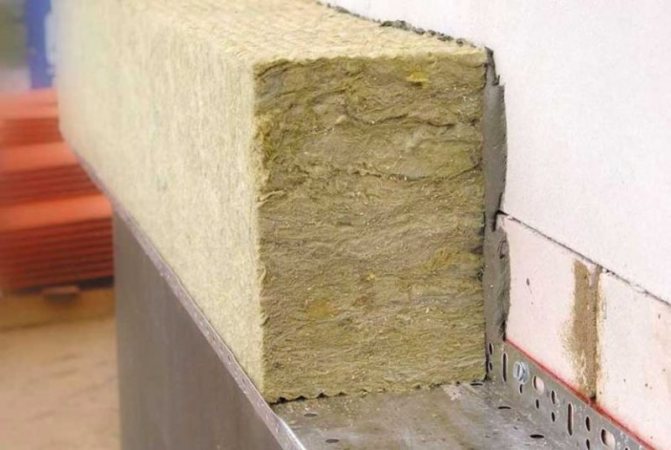

The density of the mineral wool is selected based on the area of its application.
Moisture resistance and vapor permeability
Mineral wool is capable of absorbing excess moisture, as a result of which its properties with respect to strength and durability deteriorate. But the replacement of liquid by air masses leads to a strong increase in thermal conductivity, therefore, the operational properties of the plates deteriorate.
The best option is the use of special fillers at the production stage, which hydrophobize the final product. The current GOST indicates that the level of moisture resistance of mineral wool boards should vary between 4-7 pH.
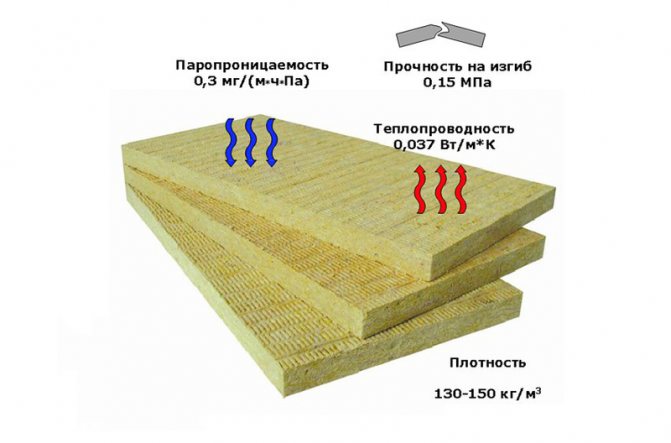

Mineral wool has excellent acoustic properties and allows you to improve airborne sound insulation of premises.
As for vapor permeability, mineral wool has the highest rate in comparison with other heaters - 480 × 10−6 g / (m × h × Pa). Insulating structures that do not have a vapor barrier (material for finishing external walls under plaster) or are equipped with a gas-permeable layer optimally preserve normal gas exchange. As a result, a favorable microclimate is created inside the room.
Chimney insulation materials
It is advisable to lay a project for insulating chimneys at the time of building a house or summer cottage, but it is possible to carry out work on thermal insulation at any stage, even if the dwelling has already been erected. Next, we will consider the main methods, methods and materials that are suitable for the implementation of this procedure.
How can you insulate a chimney
The integrity of the chimney is affected by two main factors, which it is necessary to take into account in the process of carrying out insulation work:
- Dew point. This point concerns the release of condensate, the negative impact of which was discussed above. The fact is that in the absence of proper thermal insulation, the dew point shifts into the pipe. That is, warm air that rises during the heating of the room rises up from the direct heating source, reaches a certain point inside the chimney, and settles there in the form of condensation drops. This is especially dangerous for metal and brick products, since excess moisture is absorbed by the material and destroys it from the inside, freezing and turning into ice;
- aggressive negative impact of the gases emitted from combustion.During the heating process, harmful chemical compounds inevitably appear, which destroy the entire home heating system. This is especially true for weak acidic solutions of nitrogen or sulfur. With prolonged exposure, they can destroy the chimney from almost all materials.
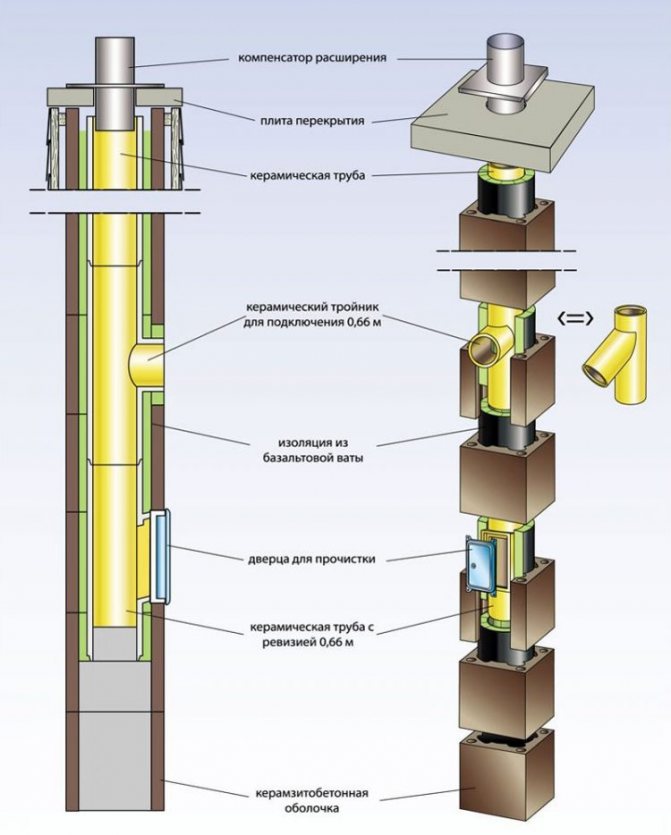

To protect yourself from such harmful factors, you can choose one of the following insulation:
- non-combustible slag wool insulation for the chimney;
- glass wool;
- basalt wool.
The most popular and used are heat insulators made of basalt wool.
Non-combustible thermal insulation materials made of slag wool
This version of the chimney liner is available in two forms: rolls and mats. It also differs in density and size, depending on the individual characteristics of the pipe, the purposes of the cladding and other design factors, which are taken into account separately in each case.
Their main feature is the preservation of structure and properties even with strong heating up to +400 o C. They are fire resistant and non-flammable, therefore they minimize the risk of fire.
Metallurgical slags are used as raw materials for manufacturing.
The disadvantages of this material include:
- the presence of residual acidity;
- the possibility of a hostile environment when moisture enters the material.
Despite these negative aspects, this fire-resistant insulation for the chimney is widely used in repair and insulation work, as it maintains an ideal ratio of price and quality.
Glass wool insulation materials
Glass wool is an insulating material with a fibrous structure. It is produced from broken glass or raw materials used during glass melting.
Depending on the manufacturing method, glass wool is divided into:
- thin, which is obtained by spinning (drawing) from molten glass;
- rough through blowing.
Glass wool is sold in the form of rolls or slabs.
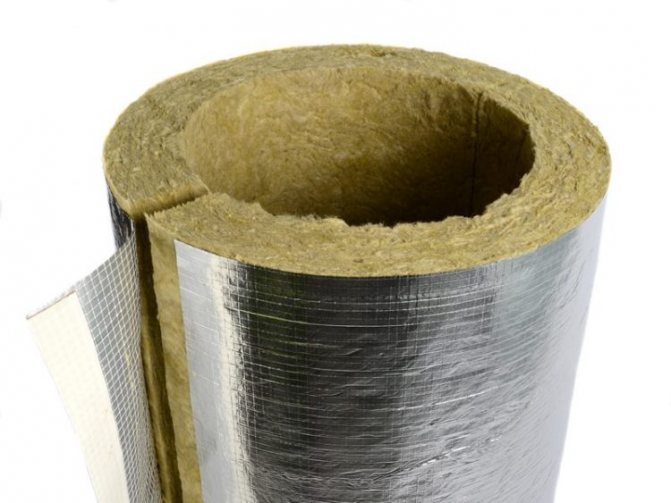

Heaters for basalt wool pipes
Basalt rocks are used as raw materials for the production of insulation.
- The way of using inorganic elements provides a complete counteraction to rotting and fungi.
- Basalt wool for a chimney has high strength and heat resistance, so it is preferred to use it as non-combustible thermal insulation to prevent fires inside the chimney.
- The insulator sits well and adapts to the surface of the insulation. Has a long service life. After installation, it serves without losing its characteristics for 30-40 years.
- By strength, basalt wool is divided into: soft, semi-rigid and hard.
Basalt wool has an additional useful property in the form of protection from moisture, therefore it is a more versatile method of thermal insulation in comparison with glass wool or slag fiber.
Technical parameters and types
Mats made from mineral fibers differ in technical characteristics that depend on the density of the product, the location of the fiber raw materials and the quality of the raw materials involved.
Experts advise, when choosing a heater, to take into account the specifics of the scope of application, to compare it with the properties of the required product.
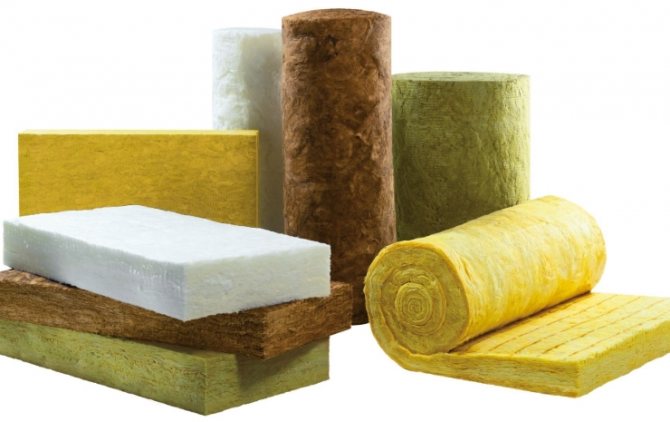

Experts advise, when choosing a heater, to take into account the specifics of the scope of application, to compare it with the properties of the required product
As for the variety of slabs for the floor, ceiling and walls, it is represented by slag, glass wool and stone wool. It is worth dwelling on each option in more detail:
- Glass wool is the most affordable insulation in this series. The initial raw material is limestone, dolomite, soda, sand, borax. From all this, fiber is produced in 5-15 microns, reaching 15-50 mm in thickness.The permissible temperature range at which the material is allowed to be used varies from -60 to + 450 ° C. Over time, glass wool can cake, which leads to a decrease in its heat-shielding function. In the process of work, this fragile material breaks down, so it is imperative to use protective equipment. Prevention of glass dust entering the room is ensured by a special vapor barrier.
- Slag wool is distinguished by a low indicator of environmental safety, since it is produced from blast-furnace slag. Due to this feature, the insulation is not recommended for installation inside residential premises. The fiber reaches 4-12 microns in thickness, its length is 16 mm.
- The safest and most effective is the basalt version of mineral wool as a heat insulator. The material does not crumble, does not penetrate into the air inside the room, has high wear rates, is durable and fire-resistant. If phenol-formaldehyde resins are not involved in the production process, basalt slabs can be called completely environmentally friendly. Their significant drawback is their high price.
If we consider the structural feature of the miniplates, then they are distinguished by a chaotic or lamellar arrangement of fibers.
Glass wool - burning or not
This type of mineral wool insulation is considered the most affordable, and therefore often used in the process of thermal insulation. The main difference between the material and stone and slag wool is its special structure with spiky fibers. Working with her is difficult and dangerous.
The thickness of glass wool fibers is from 5 to 15 microns, the length ranges from 15-50 millimeters. It is due to them that the insulation turns out to be so durable, elastic and resilient. They must work with glass wool in protective clothing, a respirator and gloves.
With a minimum coefficient of thermal conductivity, the insulation can burn at temperatures from +500 degrees Celsius, but manufacturers recommend not to allow heating above 450 degrees.
Construction insulation IZOMIN
On the basis of basalt fiber obtained by melting rocks, a wide range of heat and sound insulation products is produced for use in various structural elements (roofs, partitions, walls, floors, etc.) of buildings and structures for various purposes. The quality of the products fully complies with international standards. All IZOMIN products belong to the group of non-flammable materials and contain water-repellent additives. Products are packed in plastic wrap.
| Product name | Recommended area of application | Density (kg / m3) | Overall dimensions, mm) | Thermal conductivity at 250C (W / m • K), no more | Compressive strength at 10% linear deformation (kPa), not less | Water absorption at full immersion by volume (%), no more | Content of organic substances by weight, (%), no more | Moisture by mass (%), no more | Peel strength of layers (kPa), not less | Water vapor permeability (mg / m • h • Pa) | Flammability class according to GOST 30244 |
| Izomin Light | As unloaded heat and sound insulation of horizontal, vertical and inclined building envelopes of all types of buildings, including low-rise and cottage-type individual buildings. | 35 50 | 1000x500x50-200 1000x500x50-200 | 0.037 0.036 | — — | 2,0 2,0 | 2,5 2,5 | 1,0 1,0 | — — | 0,38 0,38 | NG NG |
| Izomin Kaviti | As unloaded heat and sound insulation of horizontal, vertical and inclined building enclosing structures of all types of buildings, including for the installation of floors, ceilings, internal partitions. As a heater in light frame-type enclosing structures. As a middle heat-insulating layer in three-layer lightweight walls of low-rise buildings made of bricks, expanded clay concrete, aerated concrete and other blocks. | 60 70 | 1000x500x50-200 1000x500x50-200 | 0,036 0,036 | 3,0 3,5 | 2,0 2,0 | 3,0 3,0 | 1,0 1,0 | — — | 0,38 0,38 | NG NG |
| Izomin Venti | On the outside of all types of buildings as a heat and sound insulation layer when installing facade structures with a ventilated gap. | 80 90 100 | 1000x500x50-200 1000x500x50-200 1000x500x50-200 | 0,035 0,035 0,035 | 6,0 17,5 20,0 | 1,5 1,5 1,5 | 3,5 3,5 3,5 | 1,0 1,0 1,0 | 2,5 5,0 5,5 | 0,37 0,37 0,37 | NG NG NG |
| Izomin Facade | On the outside of all types of buildings as a heat and sound insulation layer, followed by plastering or applying a protective covering layer. | 150 160 175 | 1000x500x20-100 1000x500x20-100 1000x500x20-100 | 0,037 0,037 0,038 | 40,0 50,0 60,0 | 1,5 1,5 1,5 | 4,5 4,5 4,5 | 1,0 1,0 1,0 | 10,0 11,0 12,0 | 0,37 0,37 0,37 | NG NG NG |
| Izomin Ruf-N | As a lower heat and sound insulation layer in multi-layer coatings of flat roofs, including when laying on a surface without a cement screed. It is recommended to use Izomin RUF-N plates in combination with Izomin RUF-V plates. | 110 120 130 | 1000x500x40-150 1000x500x40-150 1000x500x40-150 | 0,035 0,035 0,036 | 24,0 28,0 33,0 | 1,5 1,5 1,5 | 3,5 4,0 4,0 | 1,0 1,0 1,0 | 5,5 6,0 6,5 | 0,37 0,37 0,37 | NG NG NG |
| Isomin-Ruf | As a heat and sound insulating layer in flat roof coatings, including when laying on a surface without a cement screed. | 140 150 160 | 1000x500x40-120 1000x500x40-120 1000x500x40-120 | 0,037 0,037 0,037 | 35,0 40,0 50,0 | 1,5 1,5 1,5 | 4,5 4,5 4,5 | 1,0 1,0 1,0 | 7,5 8,0 9,0 | 0,37 0,37 0,37 | NG NG NG |
| Izomin Ruf-V | As an upper heat and sound insulation layer in multi-layer coatings of flat roofs, including when laying on a surface without a cement screed. It is recommended to use Izomin RUF-V plates in combination with Izomin RUF-N plates. | 180 190 200 | 1000x500x30-60 1000x500x30-60 1000x500x30-60 | 0,038 0,038 0,038 | 62,0 65,0 70,0 | 1,5 1,5 1,5 | 4,5 4,5 4,5 | 1,0 1,0 1,0 | 10,0 11,0 12,0 | 0,37 0,37 0,37 | NG NG NG |
By agreement with the customer, it is possible to manufacture products of non-standard sizes, in the range of lengths up to 2000mm and widths up to 1000mm.
Conclusions and research
Non-combustible mineral wool according to the fire safety class belongs to the NG group, although the limits of resistance to fire for heaters made from different raw materials differ. In the production of mineral heat insulators, polymers are often used as a binder. They are flammable formaldehyde resins.
Organic additives impair the fire resistance of the material, but the degree of their influence on the flammability of the material is exaggerated. The content of polymers in mineral wool does not exceed a few percent, if the insulation is produced by a bona fide manufacturer.
Thermal insulation has a lower ability to support combustion, in the production of which bentonite clays are used as a binder. The combustion temperature of mineral wool in this case can be + 1000 ° C. Fire resistance of slag wool is limited to + 250 ° С, and glass wool - + 450 ° С.
Basalt insulation is the most fireproof material. Their advantage over other mineral heat insulators has been confirmed by experiments carried out by Rockwool specialists. The test procedure was developed on the basis of GOST 30403-2012.
You can check whether stone wool is burning at home. Repeated experiments in which they tried to set fire to plates of mineral thermal insulation with gas welding equipment, showed its high resistance to fire.
Comparative technical characteristics of the mineral slab
Today, a large number of reliable heat-shielding materials are produced. The table shows the technical characteristics of three common new generation insulators:
- synthetic polymeric foam boards;
- foamed polystyrene;
- mineral slabs for walls (facade) insulation "Isover".
| Indicators and Materials | Polyfoam PSB-S 15 | Foamed polystyrene plates Technoplex | Front plate Isover |
| Density, kg / m3 | 8-10 | 28-35 | 34-165 |
| Compression resistance, kPa | 500 | 250 | 45 |
| Flexural strength, MPa | 0,07 | 0,3-0,7 | — |
| Tensile strength, kPa | — | — | 4-15 |
| Thermal conductivity, W / m * K | 0,037 | 0,029 | 0,037-0,053 |
| Water absorption in 24 hours, kg / m2 | 0,01 | 0,2 | 1 |
| Flammability | G3 | G4 | incombustible |
| Additionally: average price per m2 | 34-84 | 198 | 140 |
Comparative analysis shows that, with similar indicators, mineral insulation is fire-resistant, differs in variability in density, has a better compressive ability, which is useful for packaging and transportation. The price of a min-plate (50 mm) Isover is preferable to the cost of the innovative polystyrene foam Technoplex. The disadvantages include relatively high water absorption and large mass.
Which manufacturer should you choose?
Insulators of the Isover trademark are distinguished by innovative technologies for the manufacture of harmless, non-dusting cotton wool, combining softness, elasticity and strength.The company is the world leader in terms of production volumes and the only manufacturer of mineral wool boards represented in the Russian Federation.
Miniplates "Ursa" (the brand of the Spanish concern Uralita, which has 3 production sites in Russia) is versatility and the best performance: external and internal insulation of them is easy to install / dismantle; safety and durability. The structure of staple (cut) fiber conglomerates imparts special chemical and physical properties to thermal insulation layers made of Ursa mineral wool:
- low specific gravity;
- stability of strength indicators;
- plasticity of the surface.
Danish (literally, stone wool) is the oldest manufacturer of basalt wool (since 1937). Today there are more than 20 high-tech enterprises in 15 countries producing miniplates for any structures erected in residential and industrial construction.
Unlike fiberglass materials, the Rockwool mineral basalt slab is a volumetric canvas formed from randomly entangled fibers with numerous intersection points of the threads. This structure imparts strength and stability to the material with significant flexibility.
The cost
Average prices of the above brands are presented in the table:
| Name | Application | Dimensions, mm | Price per m2, rubles | ||
| Length | Width | Thickness | |||
| Isover (stone fiber) | |||||
| Isover Optimal | Non-stressed surfaces | 1000 | 500 | 100 | 199,58 |
| Isover Venti | Curtain facades | 1200 | 600 | 100 | 398,36 |
| Izover Facade | Facades for plastering | 1200 | 600 | 100 | 654,05 |
| Isover Ruf N Optimal | 1200 | 600 | 100 | 420,53 | |
| Ursa Geo (fiberglass) | |||||
| Ursa Geo Wireframe | Frame constructions | 1000 | 600 | 50 | 152,00 |
| Ursa Geo P-15 | Floors, partitions | 1250 | 600 | 50 | 70,00 |
| Ursa Geo (universal) | Walls, for private housing | 1000 | 600 | 50 | 66,50 |
| Rockwool Mineral Slab | |||||
| Facade Butts | External walls, under plaster | 1000 | 600 | 50 | 343,75 |
| Light Butts Scandic | Thermal insulation universal | 1200 | 600 | 100 | 161,81 |
| Acoustic Butts | Internal sound insulation | 1000 | 600 | 50 | 111,50 |
The capabilities of the leading factories make it possible to produce a wide range of standard sizes in a compact package that is convenient for transportation.
The cost of materials exceeds all other costs in the amount of financial costs for insulation. However, one should take into account the dependence of the total cost on the type of installation work. Spraying liquid foam per unit area, for example, costs 1200 rubles. Convenience and relative cheapness of the installation of mineral plates - from 80 rubles / m2 (floor sound insulation) to 300 rubles / m2 (roof protection) - makes their use most effective.
Wall insulation technology with mineral wool
Mineral wool insulation is used for sound and thermal insulation of the following enclosing structures:
- exterior walls of buildings for subsequent plastering;
- multilayer walls with insulation inside the masonry;
- ventilated facades;
- frame partitions;
Insulation of walls for plastering
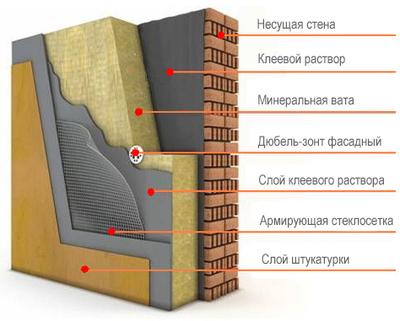

Insulation of walls for plastering
The technology of wall insulation with mineral slabs for plastering consists in the sequential performance of the following operations:
- preparatory work - leveling in the presence of significant irregularities, cutting off protruding metal elements, cleaning and dedusting;
- fastening plates of grade not less than P-160 in terms of density using a polymer-mineral adhesive and additional fastening with dowels with a galvanized metal core - not less than 8 pcs / 1 m². The bottom row of slabs is installed on a perforated metal corner with a section of 25x25x0.5 pre-fixed on the wall;
- covering the heat-insulating layer with a protective adhesive composition up to 8 mm thick with reinforcement with a plaster polymer mesh;
- application of white plaster composition up to 4 mm thick;
- painting with facade paints on the basis of an architectural design for the design of facades.
The thermal insulation thickness of the insulation is selected on the basis of calculations taking into account the conditions of the climatic region in which the construction of the object is carried out.
The procedure for performing wall insulation work for plastering is developed in detail in the manual P 1-99 to SNiP 3.03.01-87 "Design and installation of thermal insulation of external walls of buildings for plaster", published in Belarus and the Russian Federation.
Walls can be insulated mainly from the outside. Option - wall insulation from the inside with mineral wool plus drywall - should be used only in the version when external insulation is impossible for some reason. In this case, the walls are insulated from the inside with mineral wool with an indispensable device for a ventilation gap between the insulation and the cladding to prevent the deposition of condensate moisture inside the structure.
More details about the principles of external and internal insulation can be found in the article "We reveal the secrets of polyurethane foam as a heat insulator for walls, we study its advantages and disadvantages."
Insulation of multilayer walls
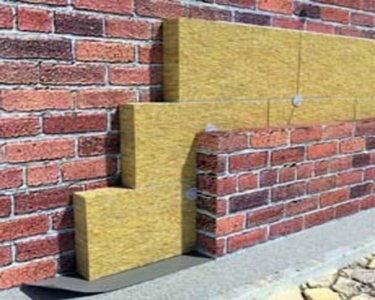

Thermal insulation of multilayer masonry
Insulation of multilayer walls is carried out in the process of brickwork or the construction of walls from small-piece or large-sized blocks. Insulation in the form of mats or slabs of the P-40 or P-50 brands in terms of rigidity fits into the air gap between the inner wall and the facing layer.
The inner masonry and the facing layer are connected by metal or polymer anchor rods, which are installed in a staggered manner with a pitch of 600x600 mm. When installing anchors, they should be placed, if possible, at the joints between the slabs; otherwise, the anchor should be passed through the slabs.
When laying the facing layer, ventilation openings should be provided - entrance in the lower part of the wall, exhaust in the upper part, which are vertical joints not filled with mortar in an amount of at least 150 cm² per 20 m² of the wall area.
Ventilated facade construction / h3>
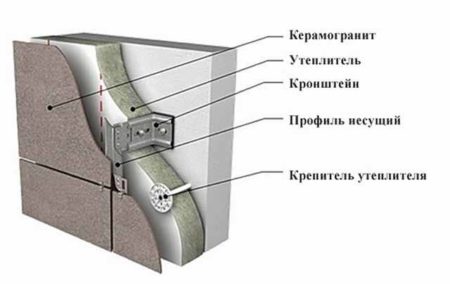

Ventilated facade
For the device of insulation using a system of ventilated facades, a frame made of metal thin-walled profiles is pre-mounted on external walls made of concrete, reinforced concrete or brick. Profiles are installed in horizontal and vertical directions with the expectation that insulation plates fit between them.
Insulation plates, the grade of which must be at least P-75 in density for buildings up to 12 m high (1-4 floors), and at least P-120 for structures over 12 m high (5 or more floors) are installed between the frame elements and fastened with dowels with wide plastic caps. For buildings up to 12 m in height, each insulation plate is fastened with two dowels, for buildings above 12 m, the insulation plate is fastened with four dowels.
A layer of insulation is covered with a windproof membrane made of a special film, then the frame with the insulation is revetted with various facade materials - siding, porcelain tiles, composite panels, etc. An air gap must be left between the surface of the insulation and the facing materials for ventilation. For buildings up to 12 m high, the size of the air gap must be at least 15 mm, for buildings over 12 m - the size of the gap must be at least 40 mm.
The thickness of the insulation is taken by calculation. In many cases, a small thickness is sufficient, for which, for example, Rocklight stone wool 50 mm thick can be used.
The device of frame partitions
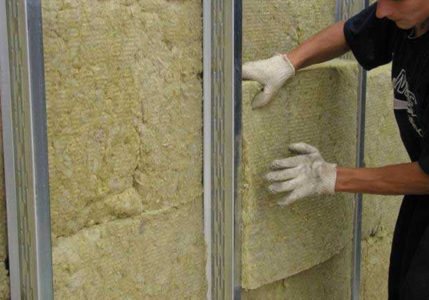

Filling the frame partitions
When filling the frame partitions, first, a frame is installed from thin-walled steel profiles or a wooden beam, consisting of racks installed on sound-insulating gaskets and horizontal crossbars. The spacing of the racks and the distance between the crossbars are selected in accordance with the dimensions of the mineral wool slabs used, with the expectation that the slabs fit tightly in the space to be filled. To fill the frame partitions, a minelite with the P-50 or P-75 grade in density is used.
After filling the frames of the partitions with mineral wool slabs, they are sheathed on both sides with gypsum plasterboards or other cladding materials, followed by finishing.
Basic properties
When choosing an insulation material for wall, floor, ceiling and roof surfaces, it is worth taking into account its thermal insulation performance.
Of no small importance is the class of fire resistance, vapor permeability, resistance to moisture. In all these respects, mineral wool outperforms many competing materials, and it also belongs to the budget category.
In all these respects, mineral wool outperforms many competing materials, and it also belongs to the budget category.
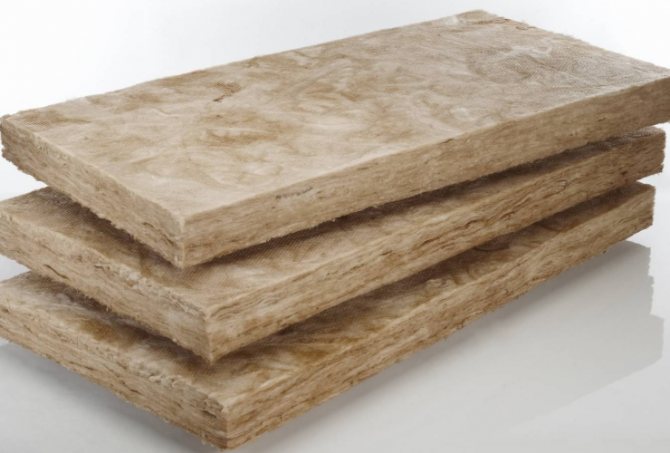

Mineral wool slabs are often used to insulate ceilings, ceilings, walls, and roofs
When starting the choice of mineral wool insulation, it is necessary to understand the main criteria by which its suitability for use in certain conditions is assessed. The fibers of the material have a number of advantages:
high strength, which is influenced by the density of the slab; insignificant weight, which is very important in preventing overloading of the created structure; prevention of rotting processes and the formation of fungi; scaring away small pests; fire resistance; service life up to 50 years.
Does glass wool burn
Glass wool, like other types of mineral thermal insulation, does not burn on its own... Only an increase in its temperature above the fire resistance limits of the material can lead to a fire. When operated in compliance with safety requirements, glass wool will not cause a fire, therefore, it is better to insulate surfaces that are not exposed to strong heating with it. The use of glass wool for heat insulation of chimneys, etc., should be discarded.
uteplix.com
Correct meaning of markings
The current standards and regulations assume the separation of mineral wool boards. Their subspecies are marked with the corresponding marks:
- Insulation P-150 is applicable as sound and heat insulation of the roof, has a high rate of fire resistance. Compression coefficient parameter is 2%, strength - 0.01 MPa and more, density - 150 kg / m³.
- The PP-125 value is used to mark the slabs of the semi-rigid type. Their main purpose is to insulate attic structures and pitched roofs. The material has a density of 125 kg / m³ and a compression of 12%, while the thermal conductivity is 0.049 W / mK.
- Rigid heat insulator plates are represented by the brands ППЖ-200, ПЖ-175. The maximum permissible load reaches 175 and 200 kg / m³, which makes the material suitable for the construction of flat roofs, which are subject to strong deformation loads.
When purchasing mineral wool, pay attention to its marking - the thickness, density of the material depends on it
Basalt wool is a suitable insulation
Among all these types of mineral wool, basalt wool is considered the most harmless, including with respect to flammability. The fibers of the material are similar in size to the slag fibers, however, unlike the first ones, they are not at all dangerous, they do not ask for specialized protection during installation work.
The thermal conductivity of basalt wool is very small, and temperature
melting can reach 600 degrees Celsius.
An improved version of basalt wool is considered to be a basalt wool insulation made of gabbro or diabase. Unlike stone, basalt additionally includes belite slimes and mineral elements:
Due to impurities, the heat insulator shows rather high flow rates. It should also be said that there is practically no formaldehyde resin in basalt mineral wool, which reduces the risk of phenol evaporation, albeit against the background of a decrease in the ability to resist the action of moisture.
Since there are practically no elements unstable to high temperatures in basalt mineral wool, the material can store functionality when heated to 1000 degrees Celsius.
Both from mineral wool stone and basalt, at the melting temperatures declared by the manufacturer, do not ignite, but only melt, which cannot be said about glass and slag.
Do-it-yourself house facade decor ideas
House facade decoration is an individual task for each owner. Someone will stop at traditional plaster or frame framing. The more progressive part will use design solutions for decorating with stucco molding. Currently, the facades of houses with a bay window are in demand.
A bay window is a part of the facade protruding beyond the wall plane, fully or partially glazed. For the decoration of such a part of the building, stucco molding is used, which frames the entire perimeter of the glazing. Under the bay window, you can install two decorative consoles, it will turn out like a box in a theater.
Everyone can find a way to decorate the facade of a house with their own hands. To do this, you can use catalogs in magazines or specialized sites on the Internet.
Production of mineral wool
The manufacturing procedure for refractory mineral wool varies depending on the characteristics and type of material. For the production of basalt slabs, inorganic (rock and dolomite) and organic (dedusting agent, water repellent, phenol-formaldehyde resin) components are used.
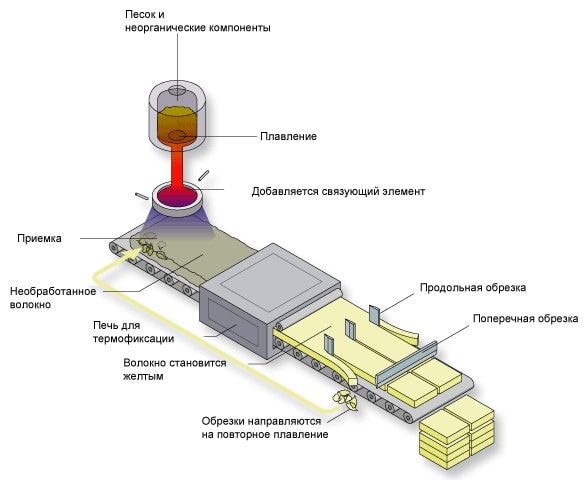

At the initial stage of manufacturing the insulation, these components are mixed with each other, after which they enter the furnace. In it, they melt at a temperature of 1600 °.
Then the mixture enters the centrifuge, in which thin threads appear under the influence of centrifugal force. They are fed to the next section of the production plant, where they are processed with organic ingredients.
At the end of the process, the resulting material is sent under a press, through which the shape of the plates is set and their elasticity is increased. Finally, the mineral wool is re-processed at a temperature of 250 °.
Advantages of slab insulation
The characteristics of hard mineral wool boards indicate their excellent exploitation properties. Due to the isolated structure, the shape is well maintained, and the product itself, if necessary, can be easily processed (cutting, drilling).
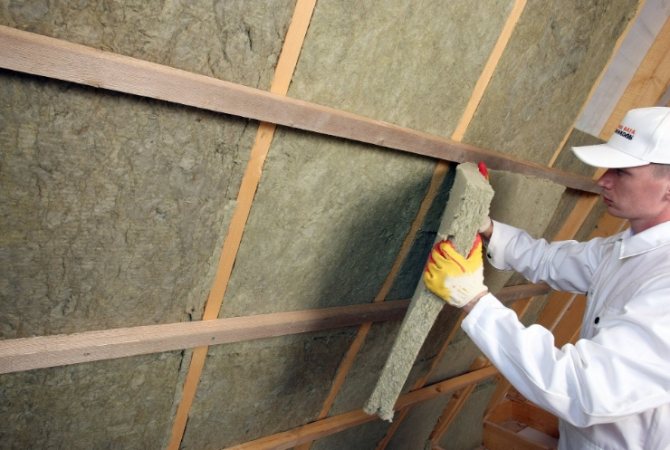

Thanks to mineral wool, you can improve sound insulation, retain heat in the room and significantly reduce heating costs
If we talk about the external arrangement of the roof, then mineral wool heat-insulating rigid plates on a synthetic binder are mounted on a previously prepared plane using special fasteners or fixing glue. On street walls under plaster, mineral wool is attached with special devices equipped with umbrella hats. An indisputable plus of the described non-combustible heat insulator lies in its affordable cost.
Some examples of use
Basalt wool is recommended to be used for insulation of building structures, which are subject to high fire resistance requirements. For instance:
A building structure made of steel profiled elements under load loses strength and undergoes critical deformations when exposed to a temperature of 450-550 ° C for a short time. When using TechnoNicol Rocklight, 100mm (2.88m2) in partitions with a metal frame, their fire resistance increases many times over and they are able to withstand high temperatures for up to 4 hours. This allows us to consider this partition as a fire-prevention one that meets the requirements for fire resistance of high-class buildings and structures.
Also, mineral wool insulation of the TechnoNIKOL Technoblock type, 50mm (8.64m2) was widely used when using engineering communications, various air ducts and pipelines in the insulation work. These structures must be designed in such a way that their fire resistance does not reduce the overall fire resistance of the entire structure. In this case, mineral wool insulation must prevent the transfer of heat and radiant energy from the hot side of the firewall to the cold one.
Areas of use
During the production of mineral wool, blast furnace slags, glass, rocks of volcanic origin are involved. From the prepared melt, processed in special centrifuges, fibers are made, which are then mixed with synthetic-based binders. The mass obtained in this way is formed into plates that are convenient for use, differing in such parameters as stiffness, density, and overall dimensions.
The resulting material based on mineral fibers is suitable for providing reliable sound and heat insulation:
- three-layer panels, roofing structures;
- overlappings;
- ceilings;
- pitched or flat roofs;
- floor coverings;
- partitions;
- load-bearing strong walls;
- three-layer special walls, built of blocks, inside which the mineral wool is placed.
Slag wool - combustible or non-combustible insulation
To have an idea of the flammability of slag, you need to understand that insulation is the result of mixing blast-furnace slags with binding components. Fibers of the material with a thickness of 4 to 12 microns, a length of 16 millimeters. The peculiarity of the material is residual acidity, respectively, and the ability to react with metal surfaces under the influence of dampness.
Insulation made from slag wool is unstable to moisture, like other more expensive mineral wool materials, and therefore cannot be used for external insulation of facade walls. For the same reason, the insulation is not suitable for the device for thermal insulation of pipes made of plastic and metal. The material is fragile and requires some care during installation and operation.
The thermal conductivity coefficient of slag wool is higher than that of the previous insulator. fiberglass. In terms of flammability, the material can hardly be called not vulnerable. The insulation begins to melt at a temperature of 250 degrees Celsius. As soon as the temperature reaches a critical point, the fibers = melt, and with them the functionality is lost.

